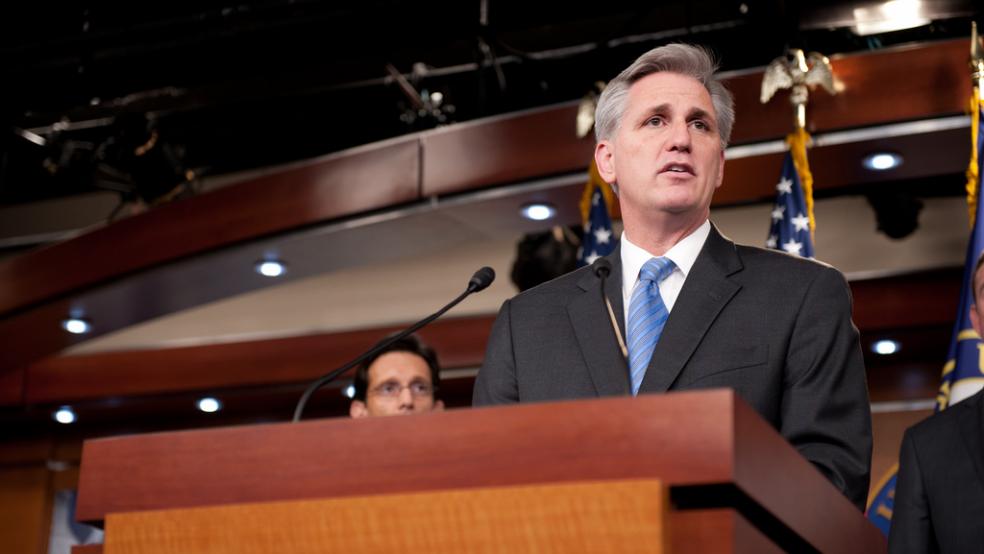As Congressman Kevin McCarthy (R-CA) climbed the House leadership ladder to majority leader this past week, the tech world ascended with him.
A big believer in the “California Dream,” the Bakersfield Republican has continually supported cutting regulation, over-litigation and other measures he says restrict business innovation.
Related: Kevin McCarthy: 10 Things You Didn’t Know About Him
“Tech people are ecstatic about him as majority leader,” said Andy Halataei, senior vice president of the Information Technology Industry Council (ITIC), a D.C.-based advocacy group. “He’s had his hand in almost every issue that was a priority for us and he’s made sure they’ve gotten through the House successfully.”
This November 2012 tweet from McCarthy captures the 49-year-old’s tech-friendly approach: “We need to simplify the lives of our local small business owners and entrepreneurs and let them innovate, create, and hire."
If that sounds that the usual GOP grist for the mill, McCarthy’s support of surveillance reform legislation, free trade, and granting more visas to high-skilled foreign workers make him a favorite of an industry critical to his state’s economy. In 2013, he led the charge on a patent reform bill, and more recently, he’s quietly pushed for tax changes that favor the tech industry. No surprise, then, that ITIC – whose member companies include Facebook, HP, Google and Intel – voted McCarthy “Legislator of the Year” in 2012.
When McCarthy was majority whip, he was responsible for counting votes for the GOP leadership. Now, as majority leader, his key role will be in setting such priorities as the House floor vote schedule.
Related: New House Leaders Primed for Internal Power Struggles
The son of a firefighter and first Republican in his immediate family, McCarthy has long advocated for a business environment that gives entrepreneurs the freedom to both fail and take risks. “As we see entrepreneurs such as Burt Rutan and Richard Branson dare to achieve the unthinkable, we must ensure that they have the freedom to innovate and create without government making their lives more difficult,” McCarthy wrote in a 2013 pp-ed. “We need to simplify the lives of our innovators so they can focus on pushing the envelope, and not on pushing endless streams of paperwork from Sacramento and Washington bureaucracies.”
Tech industry insiders stress the importance of McCarthy’s work to bridge the gap between congressional leaders and industry leaders. Dubbing his Rayburn office a “startup for ideas,” he is the only member of the House leadership to have a member of his team 100 percent dedicated to coalitions, a position currently held by Danielle Burr.
The position was previously held by Brian Worth, who served as McCarthy’s director of coalitions for more than three years before leaving in May to take a job as Uber’s federal public policy lead. As the National Journal reported, Worth was the lead on a series of meetings designed to get key business lobbying groups – such as the National Federation of Independent Business, the U.S. Chamber of Commerce and Boeing – to support extending the Bush tax cuts.
In 2013, McCarthy led a delegation of House Republicans on an “Innovate to Create” tour of Silicon Valley. Visiting startups and entrepreneurs, the team got a crash course of sorts on how innovation leads to American job creation and economic growth.
Related: Mark Cuban on How Obamacare Could Help Startups
“Silicon Valley is the cradle of twenty-first century innovation and the home to businesses that have effectively harnessed the entrepreneurial spirit that has made this country so great,” McCarthy said in a statement about the California junket.
“Washington must be mindful of the impact its policies have in either fostering or hindering this growth. House Republicans are committed to unshackling entrepreneurs from onerous government-manufactured burdens that threaten to dampen opportunities for development so that there are no limits to what America’s innovators can imagine for our future.”
Google, Facebook, the Internet Association Roundtable, and Good Technology were among several stops on the tech tour, as Politico reported. The group also paid a visit to Engine Advocacy, a group dedicated to getting "tech startups, entrepreneurs and technologists" involved in public policy.
“He understands our industry and has been very proactive in reaching out to us to learn what we think,” said Halataei of ITIC.
McCarthy even knows about using social media – Facebook, Twitter, Flickr, YouTube, Instagram – to communicate his priorities and make connections. He even applies the “all politics is local” rule to his state and his diet: Check out his Instagram feed for a glimpse of his “double double time” at In-N-Out Burger.
Related: LinkedIn Data Reveals the Most ‘InDemand’ Employers
“Rep. McCarthy has his finger on the pulse of Silicon Valley. He intuitively understands the industry’s culture of innovation and knows what’s needed to protect it,” said Joel Kaplan, Facebook’s vice president of U.S. Public Policy. “He is also an early adopter of technology in both his professional and personal life, and there’s no better way to understand the Valley’s unique contributions to the economy.”
Perhaps there’s also no better way to earn the Valley’s financial backing, although McCarthy is hardly the only congressperson they’ve supported. According to OpenSecret.com, Larry Ellison, founder and CEO of Oracle, contributed $31,500 to McCarthy’s campaign and leadership PAC during the 2012 campaign cycle, and another $7,500 in 2014. Google pitched in $20,000 in 2012 and another $10,000 to his Leadership PAC in 2014. Microsoft gave $17,500 in 2012 and another $5,000 to his Leadership PAC in 2014. Salesforce.com, a global cloud computing company headquartered in San Francisco, gave $9,000 to McCarthy’s campaign committee in 2014.
Tech friends of McCarthy’s are optimistic about future legislative goals. “He’s coming in with the knowledge base of what the tech community needs to grow jobs,” Halataei said. “We have [more] priorities as an industry that we hope the House will move on by the end of the year,” he said, citing the trade agenda and tax extensions.
Top Reads from The Fiscal Times:





